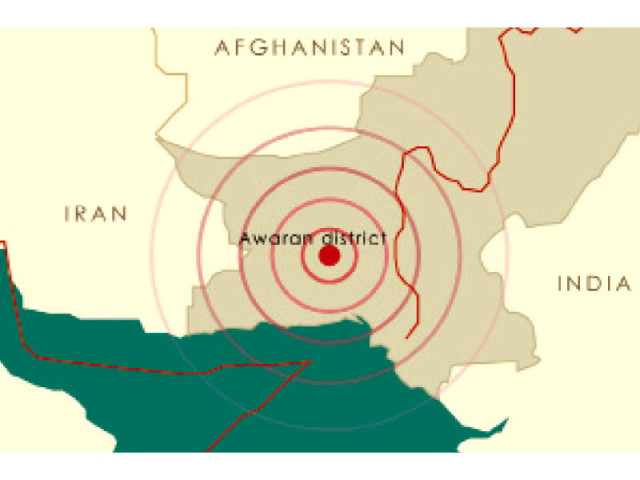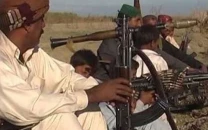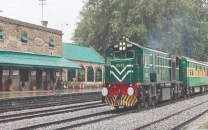Quake jolts Balochistan: Awaran flattened
Dozens killed as 7.8-magnitude earthquake hits Balochistan; half of urban and 90% of the rural district devastated.

Dozens killed as 7.8-magnitude earthquake hits Balochistan; half of urban and
90% of the rural district devastated. MAP: EXPRESS CREATIVE
In magnitude it was reminiscent of the 2005 apocalyptic temblor. It was far less deadly, though. One of the reasons may be because its epicentre was in a sparsely-populated district of Balochistan, a province where human settlements are already widely scattered. Tuesday afternoon’s massive earthquake nevertheless rattled the province, flattening hundreds of mud houses and killing dozens of people.
With little or no communication network, it was immediately difficult to determine the scale of devastation caused by the 7.9-magnitude temblor whose tremors and aftershocks were felt as far afield as the Indian capital of New Delhi and the Gulf states of Oman and the UAE. Officially, the death toll is under 100 – but the US Geological Survey (USGS) issued a red alert, warning that heavy casualties were likely based on past data.
According to the USGS, the epicentre was 23 kilometres below the ground in Awaran district. It was so powerful that it caused the seabed to rise and create a small, mountain-like island off Gwadar coast in the Arabian Sea. In 2005, a 7.6-magnitude quake centred in Azad Kashmir had caused widespread damage, killing at least 80,000 people and leaving millions shelter-less in one of the worst natural disasters to hit Pakistan.
Tuesday’s quake hit Quetta, Chagai, Dalbandin, Naushki, Panjgur, Turbat, Gwadar, Pasni, Ormara, Mastung, Kalat, Sorab, Khuzdar, Sibi, Naseerabad, Jaffarabad, Lasbela, Taftan, Nokkundi and dozens of other cities and towns of the impoverished province.
Awaran district has an estimated population of around 300,000, scattered over an area of more than 21,000 square kilometres. “Over 50% of urban and around 90% of rural areas of the district have been ravaged by the quake,” Mir Quddus Bizenjo, the deputy speaker of Balochistan Assembly, told reporters by phone. He put the death toll at 150-plus in Awaran alone.
Local journalists fear the casualties figure could be higher. Administration officials, however, gave conflicting death tolls: local tehsildar Ilahi Bakhsh said he could confirm 50 fatalities in Awaran town alone, while the commissioner of Kalat Division, Dr Akbar, said only 33 people died.
The provincial government declared an emergency in Awaran and the army mobilised its medical teams as well as 200 soldiers and paramilitary Frontier Corps troops to help with the immediate relief effort. “We have received reports that many homes in Awaran district have collapsed. We fear many deaths,” provincial government spokesperson Jan Muhammad Buledi said.
“There are not many doctors in the area but we are trying to provide maximum facilities in the affected areas.”
“All state-run hospitals in Kalat Division, of which Awaran is a part, have been put on high alert to deal with the possible influx of quake victims,” Commissioner Dr Akbar said. “If needed, the casualties could be sent to Karachi for better treatment.”
The government ordered a massive rescue operation. Army and civil rescuers have been sent to the affected region to pull out casualties as residents said dozens of people are trapped under the rubble of their collapsed houses.
The acting chief of the Provincial Disaster Management Authority, Latif Kakar, said that his agency has sent 1,000 tents and food packets to Awaran. Asked about the death toll, he said it was difficult to give a definite figure as information was pouring in from the affected region. “Damage to the cellular phone network was hampering communications in the area.”
The deputy commissioner of Awaran, Abdul Rashid Baloch, confirmed widespread death and destruction. “We have started moving the survivors into temporary shelter camps set up for them at safer places,” he told The Express Tribune by phone. “Some of the injured are being shifted to Khuzdar, Uthal and Bela.”
Chief Minister Dr Abdul Malik Baloch was saddened by the death and destruction. He directed the administration officials to assess the damages of their respective districts, prepare report and inform the provincial chief secretary.
In a statement, Dr Baloch said his government shared the grief and suffering of people and would take all possible steps to help them cope with the natural calamity. He said that with the cooperation of army, helicopters would be used to carry out relief activities in the areas which are not accessible by land.
High-Intensity Quakes Since October 2005
October 8, 2005

Magnitude: 7.6-7.8
Death toll: 80,000
Epicentre:
Muzaffarabad District, AJK
October 29, 2008

Magnitude: 6.4
Death toll: 215
Epicentre:
Ziarat, Quetta
January 18, 2011

Magnitude: 7.2
Death toll: —
Epicentre:
Dalbandin, Balochistan
April 16, 2013

Magnitude: 7.9
Death toll: 1
Epicentre:
Saravan, Iran (near Pak border)
September 24, 2013

Magnitude: 7.8
Death toll: Over 40
Epicentre:
Awaran District, Balochistan
Published in The Express Tribune, September 25th, 2013.


















COMMENTS
Comments are moderated and generally will be posted if they are on-topic and not abusive.
For more information, please see our Comments FAQ